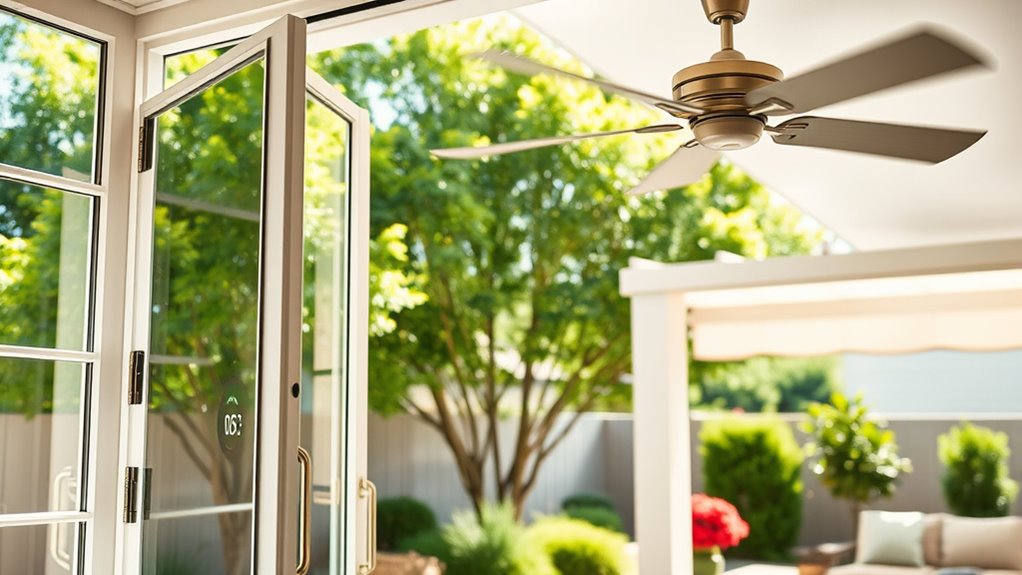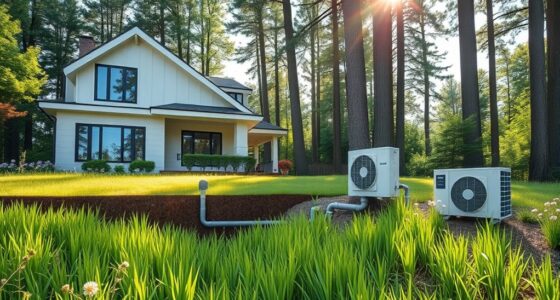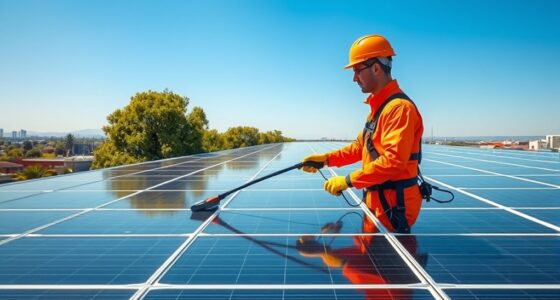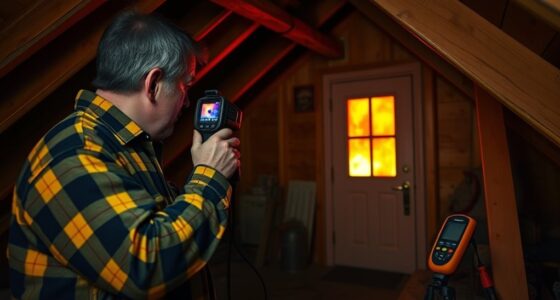To keep your home cool efficiently this summer, set your thermostat 1°F higher to save energy, and raise it up to 7°F when you’re away. Use ceiling fans, close curtains during hot days, and open windows at night for cooler air. Run appliances during cooler times, keep vents clear, and seal gaps around windows and doors. Using shading and energy-efficient windows also helps. Stay tuned for more tips to maximize your energy savings effortlessly.
Key Takeaways
- Set your thermostat to 78°F during the day and raise it when away to save energy.
- Use ceiling fans and keep vents clear to improve air circulation efficiently.
- Close curtains and blinds during peak heat hours to reduce indoor temperature.
- Run heat-producing appliances like dryers at night to lessen daytime indoor heat gain.
- Insulate and seal windows and doors to prevent heat infiltration and maintain cooler indoor temperatures.
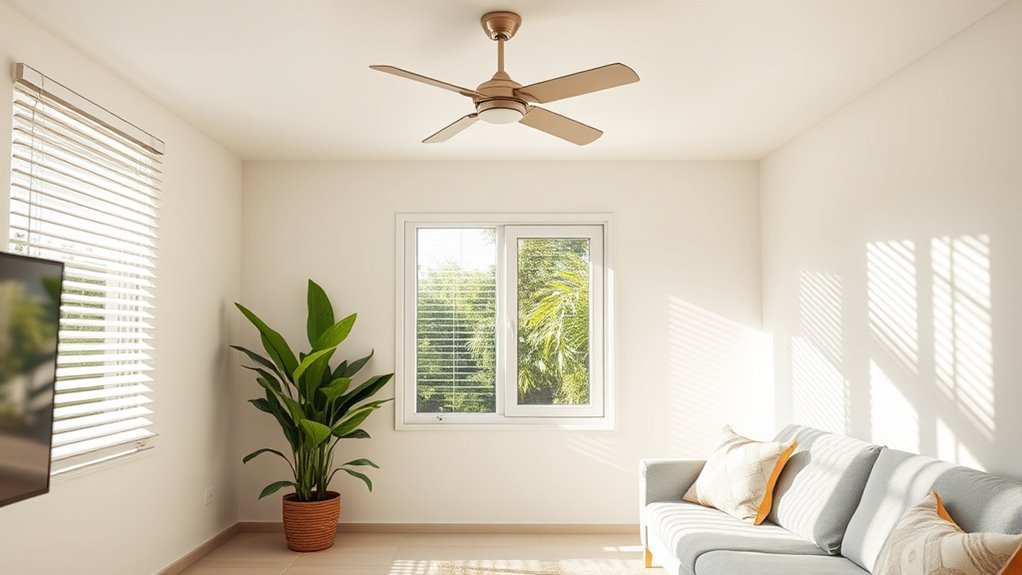
Looking to cut your summer energy bills while staying cool? Small adjustments can make a big difference. Start by managing your thermostat wisely. Setting it just one degree higher can save you 1% to 3% on energy costs, and raising the temperature by 7 degrees can cut your bills by up to 10% annually. During the day when you’re home, aim for 78°F, and when you’re away or unoccupied, bump it up to 85°F. At night, keeping it around 82°F helps you sleep comfortably while still reducing energy use. Maintaining a consistent temperature prevents your cooling system from working overtime and keeps energy demand steady. Don’t forget to adjust the thermostat when you’re not home; it can substantially cut down on unnecessary energy consumption. Choosing the right USB cable type can also enhance energy efficiency for your devices, reducing unnecessary power drain.
Using major appliances efficiently also helps. Run your dryer and dishwasher during cooler parts of the day, like early mornings or late evenings, to lessen indoor heat gain. Using heat-producing appliances at night keeps your home cooler during the day. Regularly cleaning your appliances ensures they operate at peak efficiency, which conserves energy and extends their lifespan. Proper ventilation is key, so keep vents for your heat pump or air conditioner clear of obstructions. Closing curtains and blinds during the hottest part of the day prevents sunlight from heating your rooms, and opening windows at night allows cooler air inside. Using ceiling fans to circulate air creates a pleasant cooling effect without increasing energy consumption. Proper insulation and sealing gaps around windows and doors stop warm air from entering, maintaining a cooler indoor environment. Weatherstripping and caulking help prevent heat gain, and upgrading to energy-efficient windows can make a noticeable difference.
Lighting and electrical use also impact your summer energy bills. Turn off lights when they’re not needed, especially during the day when natural sunlight suffices. Switch to energy-efficient bulbs and use timers or smart plugs to control lighting automatically. Regularly inspecting your electrical systems ensures they operate efficiently, preventing waste. For your cooling systems, keep filters clean or replace them regularly, and make sure your air conditioner is the right size for your space. Position units in shaded areas to reduce workload, and schedule regular maintenance to catch leaks or inefficiencies early. Installing a programmable thermostat helps automate temperature adjustments, ensuring your home stays cool without wasting energy.
Outdoor strategies add to your savings. Use awnings or light-colored paint to reflect heat away from your house. Cover your pool with a cover and choose energy-efficient equipment to cut costs. Shortening the operating hours of pool filters and pumps reduces energy use, and switching to solar-powered outdoor lights can further lower electricity bills. Implementing these tips helps keep your home comfortable during the summer months while saving money and energy, making your home more eco-friendly and budget-conscious.
Frequently Asked Questions
How Can I Reduce Indoor Heat Gain Effectively?
To reduce indoor heat gain effectively, you should focus on shading and insulation. Install shading devices like awnings, blinds, or solar screens to block direct sunlight. Use energy-efficient window coverings to reduce heat through glass. Improve insulation in your roof, walls, and attic to prevent heat transfer. Additionally, guarantee proper air sealing and natural ventilation to keep your home cooler and reduce reliance on air conditioning.
Are There Eco-Friendly Cooling Options Suitable for Small Homes?
You’re looking for eco-friendly cooling options for small homes. Consider installing reflective window films or shading devices like awnings to block direct sunlight. Use natural ventilation by opening windows at night and employing ceiling and floor fans for air circulation. Plant shade trees nearby to reduce heat gain naturally. These strategies are sustainable, cost-effective, and work well to keep your home cool without relying heavily on energy-intensive systems.
What’S the Best Way to Maintain My Air Conditioning System?
To keep your AC running efficiently, you should regularly replace or clean filters, ideally every one to two months, especially if you have pets or live in a dusty area. Clean the coils and condenser to prevent dirt buildup, and check your thermostat settings to match your comfort needs. Also, inspect electrical connections and lubricate moving parts. Regular professional maintenance guarantees your system stays in top shape and saves energy.
How Can Window Treatments Improve Cooling Efficiency?
You can enhance cooling efficiency by using window treatments like cellular shades or automated shades, which block or reflect heat from sunlight. Schedule them wisely to maximize energy savings, especially during the hottest parts of the day. Choosing high-performance materials reduces solar heat gain, helping keep your home cooler without overworking your AC. Regularly adjusting and maintaining these treatments ensures they stay effective in maintaining a comfortable indoor temperature.
Can Outdoor Shading Techniques Lower Indoor Temperatures?
Outdoor shading techniques can definitely lower indoor temperatures by blocking direct sunlight before it enters your home. Whether you choose exterior shades, trees, or dynamic systems, these methods reduce heat gain and improve comfort. Proper placement and design are key, and modern technologies can optimize their effectiveness. Implementing outdoor shading not only cools your space but also saves energy, cuts costs, and supports sustainable living efforts.
Conclusion
Think of your home as a garden, where each smart choice is a seed planted for comfort and savings. By shading windows, embracing natural breezes, and adjusting your thermostat wisely, you cultivate a cooler, more efficient space. As you nurture these habits, you’ll see your energy bills shrink like wilting flowers, replaced by the vibrant bloom of savings and comfort. With each mindful action, you’re watering your home’s potential for a breezier, more sustainable summer.

